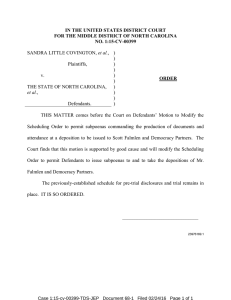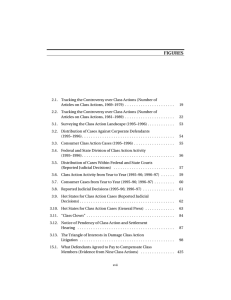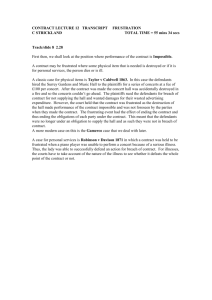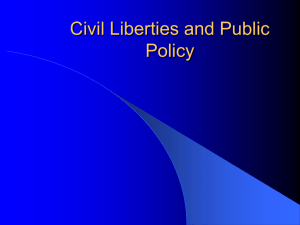was located. A huge temporary camp of workmen, engineers,
advertisement
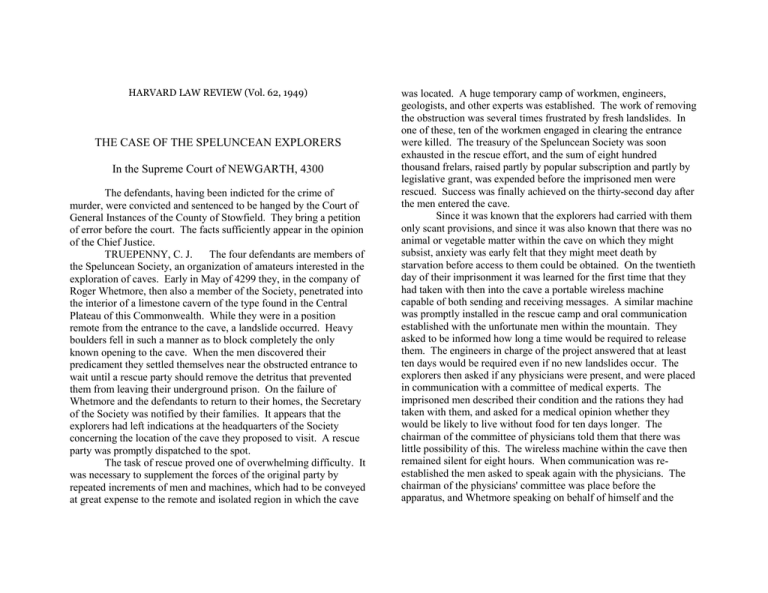
HARVARD LAW REVIEW (Vol. 62, 1949) THE CASE OF THE SPELUNCEAN EXPLORERS In the Supreme Court of NEWGARTH, 4300 The defendants, having been indicted for the crime of murder, were convicted and sentenced to be hanged by the Court of General Instances of the County of Stowfield. They bring a petition of error before the court. The facts sufficiently appear in the opinion of the Chief Justice. TRUEPENNY, C. J. The four defendants are members of the Speluncean Society, an organization of amateurs interested in the exploration of caves. Early in May of 4299 they, in the company of Roger Whetmore, then also a member of the Society, penetrated into the interior of a limestone cavern of the type found in the Central Plateau of this Commonwealth. While they were in a position remote from the entrance to the cave, a landslide occurred. Heavy boulders fell in such a manner as to block completely the only known opening to the cave. When the men discovered their predicament they settled themselves near the obstructed entrance to wait until a rescue party should remove the detritus that prevented them from leaving their underground prison. On the failure of Whetmore and the defendants to return to their homes, the Secretary of the Society was notified by their families. It appears that the explorers had left indications at the headquarters of the Society concerning the location of the cave they proposed to visit. A rescue party was promptly dispatched to the spot. The task of rescue proved one of overwhelming difficulty. It was necessary to supplement the forces of the original party by repeated increments of men and machines, which had to be conveyed at great expense to the remote and isolated region in which the cave was located. A huge temporary camp of workmen, engineers, geologists, and other experts was established. The work of removing the obstruction was several times frustrated by fresh landslides. In one of these, ten of the workmen engaged in clearing the entrance were killed. The treasury of the Speluncean Society was soon exhausted in the rescue effort, and the sum of eight hundred thousand frelars, raised partly by popular subscription and partly by legislative grant, was expended before the imprisoned men were rescued. Success was finally achieved on the thirty-second day after the men entered the cave. Since it was known that the explorers had carried with them only scant provisions, and since it was also known that there was no animal or vegetable matter within the cave on which they might subsist, anxiety was early felt that they might meet death by starvation before access to them could be obtained. On the twentieth day of their imprisonment it was learned for the first time that they had taken with then into the cave a portable wireless machine capable of both sending and receiving messages. A similar machine was promptly installed in the rescue camp and oral communication established with the unfortunate men within the mountain. They asked to be informed how long a time would be required to release them. The engineers in charge of the project answered that at least ten days would be required even if no new landslides occur. The explorers then asked if any physicians were present, and were placed in communication with a committee of medical experts. The imprisoned men described their condition and the rations they had taken with them, and asked for a medical opinion whether they would be likely to live without food for ten days longer. The chairman of the committee of physicians told them that there was little possibility of this. The wireless machine within the cave then remained silent for eight hours. When communication was reestablished the men asked to speak again with the physicians. The chairman of the physicians' committee was place before the apparatus, and Whetmore speaking on behalf of himself and the defendants, asked whether they would be able to survive for ten days longer if they consumed the flesh of one of their number. The physician's chairman reluctantly answered this question in the affirmative. Whetmore asked whether it would be advisable to cast lots to determine which of them should be eaten. None of the physicians present was willing to answer the question. Whetmore then asked if there were among the party a judge or other official of the government who would answer the question. None of those attached to the rescue camp was willing to assume the role of advisor in this matter. He then asked if any minister or priest would answer their question, and none was found who would do so. Thereafter no further messages were received from within the cave, and it was assumed (erroneously, it later appeared) that the electric batteries of the explorers' wireless machine had become exhausted. When the imprisoned men were finally released it was learned that on the twenty-third day after their entrance into the cave Whetmore had been killed and eaten by his companions. From the testimony of the defendants, which was accepted by the jury, it appears that it was Whetmore who first proposed that they might find the nutriment without which survival was impossible in the flesh of one of their own number. It was also Whetmore who first proposed the use of some method of casting lots, calling the attention of the defendants to a pair of dice he happened to have with him. The defendants were at first reluctant to adopt so desperate a procedure, but after the conversations by wireless related above, they finally agreed on the plan proposed by Whetmore. After much discussion of the mathematical problems involved, agreement was finally reached on a method of determining the issue by the use of the dice. Before the dice were cast, however, Whetmore declared that he withdrew from the arrangement, as he had decided on reflection to wait for another week before embracing an expedient so frightful and odious. The others charged him with a breach of faith and proceeded to cast the dice. When it came Whetmore's turn, the dice were cast for him by one of the defendants, and he was asked to declare any objections he might have in the fairness of the throw. He stated that he had no such objections. The throw went against him, and he was then put to death and eaten by his companion. After the rescue of the defendants, and after they had completed a stay in a hospital where they underwent a course of treatment for malnutrition and shock, they were indicted for the murder of Roger Whetmore. At the trial, after the testimony had concluded, the foreman of the jury (a lawyer by profession) inquired of the court whether the jury might not find a special verdict, leaving it to the court to say whether on the facts as found the defendants were guilty. After some discussion, both the Prosecutor and counsel for the defendants indicated their acceptance of the procedure, and it was adopted by the court. In a lengthy special verdict, the jury found the facts as I have and found further that if on the facts the defendants were guilty of the crime charged against them, then they found the defendants guilty. On the basis of this verdict, the trial judge ruled that the defendants were guilty of murdering Roger Whetmore. The judge then sentenced them to be hanged, the law of our Commonwealth permitting him no discretion with respect to the penalty to be imposed. After the release of the jury, its members joined in a communication to the Chief Executive asking that the sentence be commuted to an imprisonment of six months. The trial judge addressed a similar communication to the Chief Executive. AS YET NO ACTION WITH RESPECT TO THESE PLEAS HAVE BEEN TAKEN, AS THE CHIEF EXECUTIVE IS APPARENTLY AWAITING OUR DISPOSITION OF THIS PETITION OF ERROR.
